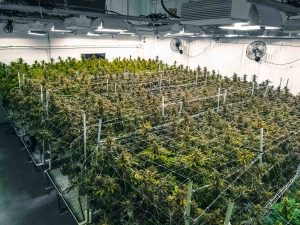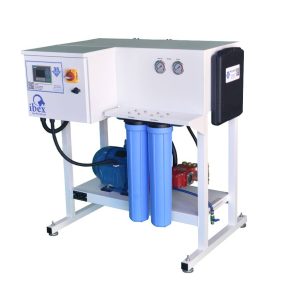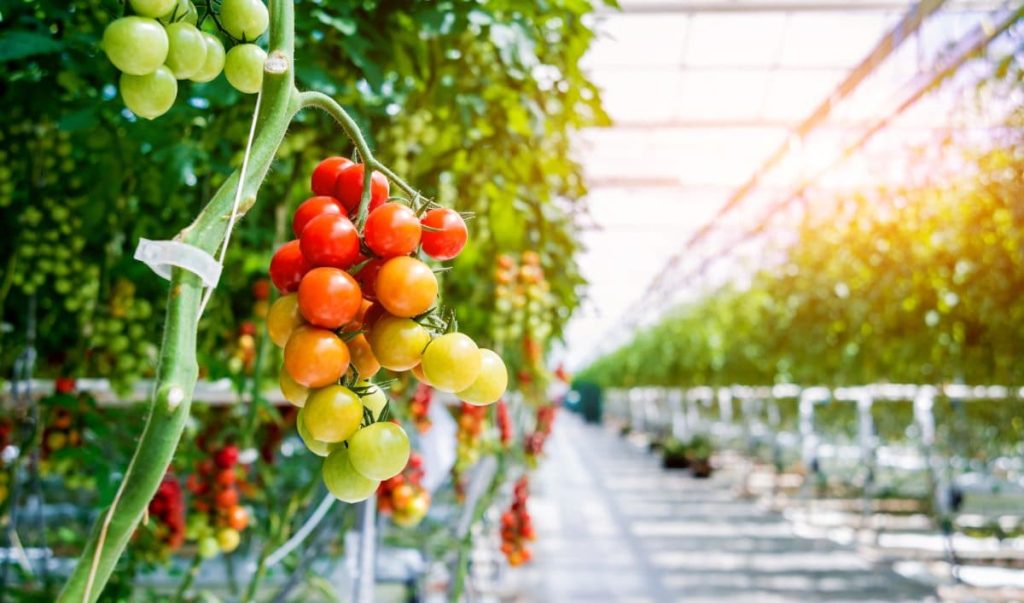Plant cultivation just works better when it is conducted inside a greenhouse or grow room. It allows growers to create a highly controlled environment for optimal growth and productivity throughout the year. A significant amount of vegetable production in the country (more than 15,000 acres) takes place inside greenhouses.
This does not even take into account the indoor and greenhouse growing operations for legalized cannabis. The top 20 growers have over 600 acres of cannabis cultivation in highly sophisticated indoor grow areas and greenhouses across the US and Canada.
Light, warmth, and humidity are three critical factors for plant growth. Humidity control is a common requirement in many industrial settings, including greenhouses. But due to the presence of a large number of plants, humidity control can be a major challenge in greenhouses and indoor grow areas.
In this blog post, we will look at the various aspects of greenhouse humidity control, and the importance of factors like vapor pressure deficit and vapor control.
What Is Vapor Pressure Deficit?
Vapor Pressure Deficit or VPD measures the level of moisture saturation in the air. It shows the difference between the maximum possible amount of vapor the air can hold and the actual amount of water vapor in the air.
Along with relative humidity and ambient temperatures, vapor pressure deficit is a key metric used by cannabis growers and greenhouse cultivators to optimize plant growth and prevent rot or decay.
VPD is expressed in pascals or kPa, a unit of pressure used in many science settings. Another popular way to express VPD is millibars, where 1 kPa is equal to 10 millibars. To better understand the significance of vapor pressure deficit, we first need to address the issue of transpiration in plants.
What Is Transpiration and Why Does It Matter?
We humans lose water in the form of vapor with every breath we take. Likewise, plants also lose water to the air throughout the day – this process is called transpiration. In some plant species like cannabis, transpiration can lead to the release of up to 95% of the water absorbed by a plant each day.
The point of water loss in plants is through the leaves. The plant continuously absorbs water from the soil via the roots to replenish the loss occurring up top at the leaves. Transpiration has the following vital functions in a plant:
- Cooling: The evaporation of water at the leaf surface uses up heat energy and helps the plant maintain an optimal temperature. This is similar to how humans sweat to reduce their body temperature.
- CO2 Re-entry: Transpiration encourages the absorption of carbon dioxide from the atmosphere for photosynthesis. During transpiration, the stomata on the leaves are open, allowing exchange between oxygen and carbon dioxide.
- Nutrient Absorption: As the plant constantly absorbs water at the roots to replace the vapor lost through transpiration, it also encourages the absorption of more nutrients from the soil.
Vapor Pressure Deficit vs. Relative Humidity
Traditionally, relative humidity was used to track the humidity levels inside a greenhouse or growing area. In fact, many growers still rely on relative humidity. While a very useful metric from a human-centered perspective (of comfort), relative humidity falls short when it comes to assuring overall plant health.
Relative humidity only looks at the saturation level of moisture in the atmosphere at a particular temperature and expresses it as percentages. That does not tell us anything about the transpiration rate in plants.
In contrast, VPD gives us a measurement of atmospheric pressure in terms of the difference between current vapor levels and maximum saturation levels possible in the grow area. This pressure level is directly linked to a plant’s ability to release water vapor.
Impact of Different VPD Levels on Plants
- High VPD (above 1.0 kPa): Plants can freely transpire as the air still has a large deficit of water vapor. While it is good for faster water and nutrient absorption from the roots, there is a risk of the plants drying out if there is not enough water supply to compensate for the losses.
- Low VPD (0.3 kPa): There is limited headroom for transpiration. This level is often optimal when plants are at the cutting/sapling stage. It reduces the chance of them drying out and also reduces the frequency at which growers have to water them.
- Zero VPD: Plants can no longer effectively transpire and release water at this level. Dew or a film of water may start forming on the plant surface, leaving it more susceptible to rot and decay. High saturation levels also promote mold growth.
Optimal Vapor Pressure Deficit Levels for Cannabis

There is no such thing as a universal VPD level that can be applied to all growing operations. Plants have different water requirements at each stage of growth. Plus, different species react in their own unique ways to fluctuations in VPD levels.
That said, there is a generally accepted VPD range for optimal plant growth in greenhouses and grow areas. This is between 0.4 kPa and 1.6 kPa, with a greater emphasis on the lower levels in the early stage of plant growth and higher levels in the later stages.
For reference, here is a quick look at the ideal VPD range for cannabis:
- Seedling stage: 0.4–0.7 kPa
- Vegetative stage: 0.8–1.0 kPa
- Flowering stage: 1.2–1.5 kPa
In the hands of a skilled grower, the VPD is a highly precise measurement for maintaining optimal conditions. This is because of the subtle connections between the different factors of temperature and humidity inside a grow area.
In an indoor grow area, you can precisely tweak the temperature settings. At higher temperatures, the air can hold more water vapor. On the other hand, if you lower the temperatures using a combination of an HVAC system and a humidification system (such as an ultrasonic cool mist humidifier), the VPD also increases.
You can influence and change VPD in an indoor grow area in several different ways:
- Increase/decrease the temperature using an HVAC system.
- Increase/decrease humidity using a humidifier or dehumidifier.
- Increase/decrease light intensity by moving lights closer to or farther from the plants.
Using different combinations of temperature and humidity levels, growers can hit the optimal VPD ranges for growth and flowering in cannabis plants. In some instances, changing VPD levels a few decimal points has shown up to a 20% increase in plant yield.
The Importance of Nighttime VPD Levels
The whole equation of VPD levels in plant growth is tied to the process of transpiration and photosynthesis. But plants do not photosynthesize at night. The levels of transpiration are replaced by respiration – a process where plants generate energy using CO2 and stored sugars, releasing oxygen and water.
Overall, VPD is less important at night when compared to during the day. However, if there are any drastic variations in temperatures, which can happen in outdoor grows, it is important to keep an eye on VPD levels at night. Three things are important here:
- Keeping low humidity levels to prevent bud rot and mildew.
- Keeping VPD levels as close to daytime levels as possible.
- Avoiding large swings in VPD – above 0.4 kPa.
As a rough general estimate, daytime VPD levels are at least 10 times more important than nighttime levels. However, growers cannot afford to ignore or neglect VPD at night. Plants hate drastic changes in the environment – as long as things stay relatively close to daytime numbers, they are happy.
VPD Levels in Indoor Grow Rooms vs. Greenhouses
Greenhouses present more of a challenge for optimal VPD management than indoor grow rooms. In the latter, nearly all aspects of the environment are tightly controlled, using supplemental lighting, HVAC systems, humidifiers, and cooling fans.
But greenhouses have one major component that is not in our control – the sun. The ambient air temperature in greenhouses can change throughout the day, depending on local weather conditions and the time of the day.
Usually, fogging systems are used to improve humidity levels, decrease the temperature, and thereby control VPD levels in a growing area. These fogging systems activate when the warmer air reaches a preset temperature.
Greenhouses require more attention on the temperature levels than indoor grow areas. A high-pressure water fog system, along with optimal ventilation controls, is essential for creating the right growing conditions inside a greenhouse.
The Best Humidifier for Full VPD Control
With the right equipment installed, growers can attain unprecedented levels of control over indoor air and environmental factors like humidity, temperature, and VPD. With their ability to control both moisture levels and temperature, humidifiers are an essential tool in any indoor garden or outdoor greenhouse.
There are several different options when it comes to designs for indoor/greenhouse humidifier systems. They include:
Warm Mist Humidifiers
A warm mist humidifier uses heat energy to boil water and create steam. Once the water evaporates, it is then pumped into the grow area at safe temperature levels. With their high humidity capacity, warm mist humidifiers are ideal for greenhouses and indoor gardens housing tropical plants. They are also a good option for growers in dry/semi-arid regions with cold winter months.
However, a warm mist humidifier is quite energy-intensive and can be expensive in the long run. While awesome for providing an occasional boost to humidity levels and temperature, they are not ideal for 24/7 operations.
Cool Mist Humidifier
Cool mist humidifiers are some of the most popular types of humidifiers among both amateur growers and professional greenhouse operators. In stark contrast to warm mist humidifiers, a cool mist humidifier does not use heat to evaporate water.
Instead, it uses several different technologies (depending on the model and manufacturer) to create mist output:
Evaporative Humidifiers
A very common and affordable design, an evaporative humidifier uses fans to blow air over a moisture-wicking material. The water in the wicking material is converted into water vapor and blown into the growing area as a cold mist. Evaporative humidifiers tend to be loud due to the fan. They are also more suited for smaller indoor grow rooms than greenhouses or large grow areas.
Ultrasonic Humidifiers
These are the most expensive type of cool mist humidifier designs out there. The system uses high-frequency sound to create water vapor. Since it uses a vibrating nebulizer instead of a loud fan, an ultrasonic humidifier offers noise-free operations.
Impeller Humidifiers
The third type of cool mist humidifier design uses a rotating disc to push water towards a diffuser. The diffuser breaks water down into tiny mist particles. Impeller humidifiers are usually used in small rooms and are not generally used for high-end growing operations.
High-Pressure Fog Systems
These are advanced, industrial-grade plant humidifier systems designed for large greenhouses and indoor grow operations. Instead of fans or heat, these large-scale plant humidifier systems use powerful water pumps and specially designed nozzles to create ultra-fine cool mist.
If you want optimal dispersion of water vapor for plant cultivation in a large area, high-pressure fog systems are probably the best option. Unlike the humidifiers listed above, fog systems are highly versatile – they can also be used for small and medium room grow areas.
Regardless of the indoor garden/greenhouse size, fog systems use strategically placed nozzles to spray cool mist in an evenly distributed manner. With cool mist humidifiers, the positioning of the unit often means that some plants do not get adequate moisture.
Fog systems also come with flexible tank capacity options, pumps with different size options, and a highly customizable nozzle lines system. The atomized vapor from these nozzles provides a superior cooling effect and high humidity levels much faster than other plant humidifiers.
MicroCool High-Pressure Fog Systems – The Most Dependable Plant Humidifiers on the Market

MicroCool has over 40 years of experience designing and building customized humidification and cooling systems for greenhouses and indoor growing businesses. We have a range of products and systems that excel in creating high humidity environments while providing precise control mechanisms for temperature and VPD. They include:
- FOCUS Systems – Closed-loop, pressurized systems for instant ON/OFF humidity. They have specially designed nozzles that use high-quality solenoids to precisely control the humidification process while minimizing the risk of dripping. Additional features like zone controllers and automatic drains can covert each node into a standalone unit.
- IBEX Systems – These are industrial-grade humidifier systems ideal for large grow operations with dry air issues and higher humidity requirements. The pumps come with features like a high-efficiency motor, variable frequencies, automatic shut-off, and low energy operation.
These systems come with innovative features like rotating collars, precision control panels for temperature and VPD readings across multiple zones, programmable VPD ranges, water filter systems, UV light filters, and more.
MicroCool\’s advanced humidifier solutions are distinguished by an optional zoning system and a user-friendly interface, which gives you the flexibility to control individual zones or adjust the direction of nozzle for maximum results. This is recognized as an industry-leading standard because unlike conventional single-point solutions, the grid-like system of MicroCool humidifiers enables uniform humidity levels everywhere. The quality, precision, efficiency, and service that MicroCool offers is unmatched in the industry.
If you want the best plant humidifiers for your operation, MicroCool is a name you can trust. To learn more about our multi-room and greenhouse humidity solutions, schedule an appointment with our fog experts today.

